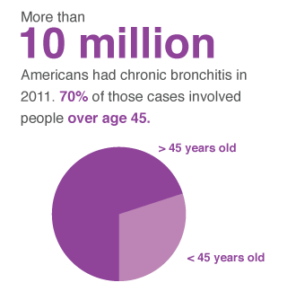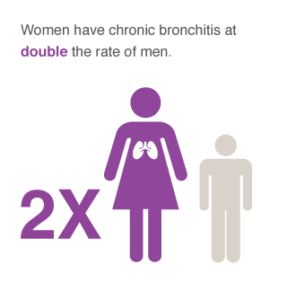Etiology
By far the most common etiological cause of COPD remains smoking. Even after the client quits smoking, the disease process continues to worsen. Air pollution and occupation also play an important role in COPD. Smog and second-hand smoke contribute to worsening of the disease.
Occupational exposure to irritating fumes and dusts may aggravate COPD. Silicosis and other pneumonoconioses may bring about lung fibrosis and focal emphysema. Exposure to certain vegetable dusts, such as cotton fiber, molds and fungi in grain dust, may increase airway resistance and sometimes produce permanent respiratory impairment. Exposures to irritating gases, such as chlorine and oxides of nitrogen and sulfur, produce pulmonary edema, bronchiolitis and at times permanent parenchymal damage.
Repeated bronchopulmonary infections can also intensify the existing pathological changes, playing a role in destruction of lung parenchyma and the progression of COPD.
Heredity or biological factors can determine the reactions of pulmonary tissue to noxious agents. For example, a genetic familial form of emphysema involves a deficiency of the major normal serum alpha-1 globulin (alpha-1 antitrypsin). A single autosomal recessive gene transmits this deficiency. The homozygotes may develop severe panlobular emphysema (PLE) early in adult life. The heterozygotes appear to be predisposed to the development of centrilobular emphysema related to cigarette smoking. The other better-known cause of chronic lung disease is mucoviscidosis or cystic fibrosis, which produces thickened secretions via the endocrine system and throughout the body.
Aging by itself is not a primary cause of COPD, but some degree of panlobular emphysema is commonly discovered on histopathologic examination. Age related dorsal kyphosis with the barrel-shaped thorax has often been called senile emphysema, even though there is little destruction of interalveolar septa. The morphologic changes consist of dilated air spaces and pores of Kohn.
Pathogenesis
The pathogenesis of COPD is not fully understood despite attempts to correlate the morphologic appearance of lungs at necropsy to the clinical measurements of functioning during life. Chronic bronchitis and centrilobular emphysema do seem to develop after prolonged exposure to cigarette smoke and/or other air pollutants. Whatever the causes, bronchiolar obstruction by itself does not result in focal atelectasis, provided there is collateral ventilation from adjacent pulmonary parenchyma via the pores of Kohn.
It has been proposed that airway obstruction at times may result in a check-valve mechanism leading to overdistension and rupture of alveolar septa, especially if the latter are inflamed and exposed to high positive pressure (i.e. barotrauma). This concept of pathogenesis of emphysema is entirely speculative. Airflow obstruction alone does not necessarily result in tissue destruction. Moreover, both centrilobular and panlobular emphysema may exist in lungs of asymptomatic individuals. It has been reported that up to 30% of lung tissue can be destroyed by emphysema without resulting in demonstrable airflow obstruction. Normally, radial traction forces of the attached alveolar septa support the bronchiolar walls. With loss of alveolar surface in emphysema, there is a decrease in surface tension, resulting in expiratory airway collapse. Additional investigative work continues in an effort to link disease states to pathogenesis.
Control of Ventilation
A brief description of respiratory control mechanisms will help the you with COPD or family members or the nurse better understand how the progression of COPD results in pathophysiologic changes. The respiratory centers impart rhythmicity to breathing. The sensory-motor mechanisms provide fine regulation of respiratory muscle tension and the chemical or humoral regulation that maintains normal arterial blood gases. This will help the nurse to understand why hypercapnia (increased PaCO2) results in the COPDers’ extreme reliance on the hypoxic drive.
The reticular formation of the medulla oblongata constitutes the medullar control center responsible for respiratory rhythmicity. The mechanism whereby rhythmicity is established is not clear, but it may be the end result of the interaction of two oscillating circuits, one for inspiration and one for expiration, which inhibit each other. Although medullar centers are inherently rhythmic, medullar breathing without pontine influence is not well coordinated; therefore, pontine as well as medullar centers participate in producing normal respiratory rhythm.
In the pons, a neural mechanism has been identified as the pneumotaxic center. Stimulation of this center leads to an increase in respiratory frequency with an inspiratory shift, whereas ablation of the center leads to a slowing of respiration. The pneumotaxic center has no intrinsic rhythmicity but appears to serve by modulation of the tonic activity of the apneustic center. The latter is located in the middle and caudal pons. Stimulation of the apneustic center results in respiratory arrest in the maximal inspiratory position, or apneusis.
Respiratory muscles, like other skeletal muscles, possess muscle spindles, which, by sensing length, form a part of a reflex loop that assures that the muscle contraction is appropriate to the anticipated respiratory load and required effort. This servo-mechanism facilitates fine regulation of respiratory movements and may stabilize the normal respiration in spite of changes in mechanical loading. Breathing is automatic when the respiratory load is constant or when changes in load are subconsciously anticipated. Thus, because it is anticipated, we are not consciously aware of the increase in expiratory resistance during phonation. Under such circumstances the increase in effort is not sensed because it is appropriate to the expected load.
It has been suggested that signals from respiratory muscle and joint mechano-receptors are integrated to produce a sensation that may reach consciousness when there is this “length tension appropriateness.”
Humoral regulation of the medullar centers is mediated by chemosensitive areas in the medulla and through peripheral chemoreceptors. Peripheral chemoreceptors are primarily responsible for the hypoxic drive. These receptors are highly vascular structures located at the carotid bifurcation and arch of the aorta. A diminution of oxygen supply results in anaerobic metabolism in cells of these carotid and aortic bodies. The resulting locally produced metabolites stimulate receptor nerve endings and, through signals conveyed to medullar control centers, lead to increased ventilation. The extremely high blood flow of the chemoreceptors and their almost immeasurable arterial-venous difference make them sensitive to reduced arterial oxygen tension (PaO2) but not to a reduction in oxygen content alone. However, a decrease in blood flow to these chemoreceptor organs, by permitting accumulation of metabolites, results in their stimulation and an increase in ventilation. Very high PaCO2 minimizes receptor stimulation regardless of blood flow.
A decrease in arterial pH also stimulates these peripheral chemoreceptors. The stimulation resulting from an increase in arterial carbon dioxide tension (PaCO2) is probably secondary to the increase in pH. The effect of pH has been attributed to dilatation of arteriovenous anastomoses in the periphery of the chemoreceptor bodies, with resulting reduction in blood flow to the chemosensitive cells. However, the effect of carbon dioxide and pH on respiration is mediated only to a limited extent by peripheral chemoreceptors. Denervation of these receptor organs abolishes the hypoxic drive to respiration but has little effect on the influence on ventilation of carbon dioxide or pH.
Changes in PaCO2 have a profound effect on central chemoreceptors located in the medulla. These are primarily responsible for mediating the hypercapnic respiratory drive. The precise location and characteristics of these central chemoreceptor sites nor their neural connections with the medullar respiratory control centers have been established. The chemosensitive areas appear to be directly responsive to hydrogen ions rather than to carbon dioxide.
Central chemoreceptors are sensitive to changes in pH, and through this mechanism they appear to be specifically responsive to PaCO2. Hydrogen ions themselves do not readily traverse the blood-brain barrier. Under normal circumstances, CO2 plays the primary role in chemical control of ventilation while PaO2 and extracellular pH have lesser roles. Normal subjects increase their ventilation more than two-fold while breathing 5% CO2 gas mixture.
Chronic elevation of PaCO2 (hypercapnia) is found in patients having COPD. The respiratory response to CO2 is markedly diminished in these clients and they become markedly sensitive to their diminished PaO2 (hypoxemia). An exuberant use of oxygen for hours may have dire consequences by removing the dominant respiratory stimulus in these clients. If a patient has Emphysema whose brain is use to high carbon diozide levels in their blood secondary to bad breathing and getting low 02 blood levels in their body so their brain gets use to being messaged to tell the patient to breath on low levels of carbon dioxide blood levels when reaching the brain. If this emphysema pt is given high doses of O2 for hours it turns the brain off making it think it doesn’t need to send messages to the person to breath. A normal person with no emphysema COPD is use to breathing due to hypoxia but a emphysema is use to breathing when they have hypocapnia. That is why when a emphysema pt who is no respiratory arrest is given 2L or less daily. When is distress high 02 levels temporarily unlikely to hurt the pt, since the high 02 is given for a short period.

